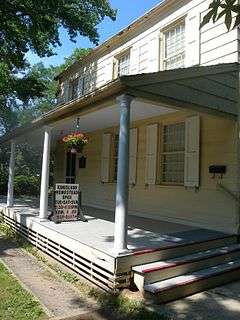Kingsland Homestead
|
Kingsland Homestead | |
|
NYC Landmark #LP-0005 | |
 | |
   | |
| Location | 37th Ave. and Parsons Blvd., New York, New York |
|---|---|
| Coordinates | 40°45′49″N 73°49′27″W / 40.76361°N 73.82417°WCoordinates: 40°45′49″N 73°49′27″W / 40.76361°N 73.82417°W |
| Area | less than one acre |
| Built | 1774 |
| Architectural style | Colonial |
| NRHP Reference # | 72000905[1] |
| NYCL # | LP-0005 |
| Significant dates | |
| Added to NRHP | May 31, 1972 |
| Designated NYCL | October 14, 1965 |
Kingsland Homestead, located in Murray Hill, Queens is a New York City landmark and member of the Historic House Trust. It is the home of the remains of a landmarked, weeping beech tree, believed planted in 1847 and located near the 17th Century Bowne House, the location of the first Quaker meeting place in New Amsterdam. The homestead houses and is operated by the Queens Historical Society and is open to the public as a museum.
About the house
Kingsland was built by Charles Doughty in approximately 1785 and the name "Kingsland" is believed to derive from Doughty's son-in-law, British sea captain Joseph King, who bought the home in 1801.[2] The house was moved for the first time in 1923 when a proposed subway extension put it in danger and it was moved to the site of a stable, also built by King. The house was threatened again in 1965, by the construction of the Murray Hill Shopping Center, but the community was able to save the house and in that same year it was one of the first buildings in the City to be declared a landmark by the Landmarks Preservation Commission.[3][4] When further construction threatened the house in 1968, the then three-year-old Kingsland Preservation Committee (now the Queens Historical Society) arranged for the transfer of the house to its present location.[2][4] After significant delays, the Homestead was officially dedicated as a museum in March 1973.[5] In October 1996 a $330,000 renovation that completely restored the house and included the addition of track lighting and a sprinkler system to protect the house was completed.[4] Further structural work was required in 1999.[6]
Exhibits

The Homestead has been interpreted to the Victorian era,[7] although it has included a wide range of exhibits since its dedication as a museum. A World War II exhibit highlighted what happened in Queens during the War and included local newspapers from the time as well as real-estate ads that highlighted the borough's growth,[4] and an exhibit on slavery showcased its impact in Queens and on Long Island.[8]
Weeping Beech
Within the main park that houses the Homestead is the 2-acre (8,100 m2) Weeping Beech Park,[9] once dominated by a landmarked 60-foot (18 m) weeping beech tree. The beech tree, one of only two living landmarks in New York City[10] when it was designated in 1966,[11] is believed to have originated in Belgium, where Samuel Parsons purchased a budded shoot and brought it with him to America and it is believed to be the source of all weeping beeches in the United States.[2][10] The tree survived for 151 years before succumbing, following a 30-year decline and fear that she would fall.[12] Seven direct descendants remain in the park, shadowing the Homestead.[13] A funeral was held for the tree in December 1998 by the city's Parks Commissioner while they decided what to do with the remains of the tree.[10] In March 1999 it was decided that the remains of the tree, save for a ten-foot section that would remain in the park as a memorial,[10] would be given to artists to use for sculptures and benches along a heritage trail in downtown Flushing.[14]
References
- ↑ National Park Service (2009-03-13). "National Register Information System". National Register of Historic Places. National Park Service.
- 1 2 3 "Kingsland Homestead, Weeping Beech Park". New York City Department of Parks & Recreation. Retrieved 2008-04-28.
- ↑ Farnsworth Fowle (1965-10-18). "First Official Landmarks of City Designated". The New York Times. Retrieved 2008-04-28.
- 1 2 3 4 Donald Bertrand (1996-10-13). "Kingsland's Royal Rehab Done 1785 Home set to Show New Look". Daily News. Retrieved 2008-04-28.
- ↑ "Kingsland Homestead Now a Museum; Many Delays". The New York Times. 1973-03-25. Retrieved 2008-04-28.
- ↑ "State to Provide $10,000 for Kingsland Restoration". Daily News. 1999-11-18. Retrieved 2008-04-28.
- ↑ Jane H. Lii (1995-08-27). "Tea, Top Hats and Tranquility". The New York Times. Retrieved 2008-04-28.
- ↑ Gayle Dewees (2000-07-27). "Movies at Dusk in Astoria Park". Daily News. Retrieved 2008-04-28.
- ↑ "Weeping Beech Park". New York City Department of Parks & Recreation. 2001-11-01. Retrieved 2008-04-28.
- 1 2 3 4 Richard Weir (1999-01-17). "Flushing; Old Tree May be Benched". The New York Times. Retrieved 2008-04-28.
- ↑ Dick Sheridan (1999-02-12). "Tree Has Reason to Cry Historic Weeping Beech to be Topped". Daily News. Retrieved 2008-04-28.
- ↑ Charlie Leduff (1997-05-11). "Venerable Beech Makes it to Her Party". The New York Times. Retrieved 2008-04-28.
- ↑ "Kingsland Homestead". Historic House Trust of New York City. Retrieved 2008-04-28.
- ↑ Richard Weir (1999-03-14). "Update; Weeping Beech Will Live On in Memory, and in Art". The New York Times. Retrieved 2008-04-28.
External links
| Wikimedia Commons has media related to Kingsland Homestead. |
- Historic American Buildings Survey (HABS) No. NY-6296, "Kingsland, Weeping Beach Park, 143-35 Thirty Seventh Avenue, Flushing, Queens County, NY", 5 measured drawings
- Queens Historical Society: Kingsland Homestead

